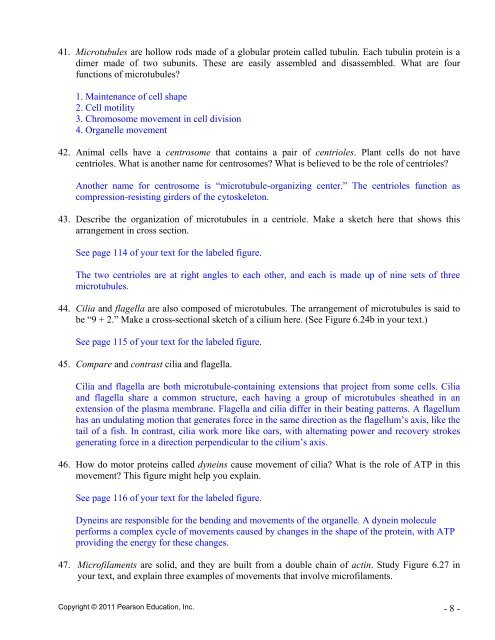You also want an ePaper? Increase the reach of your titles
YUMPU automatically turns print PDFs into web optimized ePapers that Google loves.
41. Microtubules are hollow rods made of a globular protein called tubulin. Each tubulin protein is a<br />
dimer made of two subunits. These are easily assembled and disassembled. What are four<br />
functions of microtubules?<br />
1. Maintenance of cell shape<br />
2. Cell motility<br />
3. Chromosome movement in cell division<br />
4. Organelle movement<br />
42. Animal cells have a centrosome that contains a pair of centrioles. Plant cells do not have<br />
centrioles. What is another name for centrosomes? What is believed to be the role of centrioles?<br />
Another name for centrosome is “microtubule-organizing center.” The centrioles function as<br />
compression-resisting girders of the cytoskeleton.<br />
43. Describe the organization of microtubules in a centriole. Make a sketch here that shows this<br />
arrangement in cross section.<br />
See page 114 of your text for the labeled figure.<br />
The two centrioles are at right angles to each other, and each is made up of nine sets of three<br />
microtubules.<br />
44. Cilia and flagella are also composed of microtubules. The arrangement of microtubules is said to<br />
be “9 + 2.” Make a cross-sectional sketch of a cilium here. (See Figure 6.24b in your text.)<br />
See page 115 of your text for the labeled figure.<br />
45. Compare and contrast cilia and flagella.<br />
Cilia and flagella are both microtubule-containing extensions that project from some cells. Cilia<br />
and flagella share a common structure, each having a group of microtubules sheathed in an<br />
extension of the plasma membrane. Flagella and cilia differ in their beating patterns. A flagellum<br />
has an undulating motion that generates force in the same direction as the flagellum’s axis, like the<br />
tail of a fish. In contrast, cilia work more like oars, with alternating power and recovery strokes<br />
generating force in a direction perpendicular to the cilium’s axis.<br />
46. How do motor proteins called dyneins cause movement of cilia? What is the role of ATP in this<br />
movement? This figure might help you explain.<br />
See page 116 of your text for the labeled figure.<br />
Dyneins are responsible for the bending and movements of the organelle. A dynein molecule<br />
performs a complex cycle of movements caused by changes in the shape of the protein, with ATP<br />
providing the energy for these changes.<br />
47. Microfilaments are solid, and they are built from a double chain of actin. Study Figure 6.27 in<br />
your text, and explain three examples of movements that involve microfilaments.<br />
Copyright © 2011 Pearson Education, Inc. - 8 -


